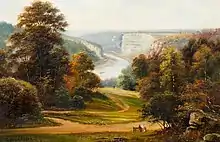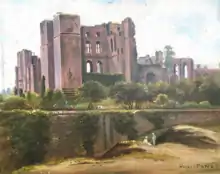George Willis-Pryce
George Willis-Pryce (1865-1949) was an English landscape painter who worked in the late 19th century and the early 20th century.[1] Several of his paintings are exhibited in galleries and museums, such as the Wednesbury Museum and Art Gallery[2] and the Bewdley Museum,[3] as well as several local pieces in Evesham Town Hall.[4] The majority of his works are held in private collections.
Life
He was born in Birmingham, Warwickshire, in 1865[5] and died in 1949 - seen from artwork labels [6] and from his probate, which was also recorded in Birmingham.[7] He married Emily Edith Hearne in 1902 in Monmouth.[8][9] A son was born in 1904 in West Bromwich, Staffordshire,[5] and in the census of 1911 the family was recorded in Weston-super-Mare, Somerset, Willis-Pryce’s occupation being noted as „Artist Painter of Pictures“.[9]
It is thought he had a connection with the town of Evesham, as he completed several works there, most of which are on display at the town hall there.[4] There are no known photographs of Willis-Pryce himself.
Artistic Technique

Most of Willis-Pryce's works are oil on canvas paintings. The detail in many of his pieces is considered especially fine, especially with trees and water, and he is noted for the composition of misty backgrounds. He used a mixture of different styles with a traditional element of fine detail along with a somewhat impressionist style of sweeping brushstrokes. For his period - this is no uncommon, as artistic styles and tastes were changing.
Willis-Pryce often painted landscape scenes, usually with no people in sight. However, of those works that do contain people, he places two in the foreground, often below the dramatic scenery to add to the sense of structure and texture in the painting - good examples of this are two of his paintings, Clifton Hill Bridge (in which two are seated on a bench) and Kenilworth Castle (in which two are stood beside a bonfire).

Willis-Pryce not only produced country landscapes, but also a handful of city and town scenes, such as Gateway to Market Square and Workman Bridge, both in Evesham, as well as a couple of pictures in Handsworth, such as View down Church Lane and Handsworth Church. He also completed a few rural buildings.
Willis-Pryce also painted a few castle scenes, such as Stokesay Castle and perhaps the more dramatic Kenilworth Castle, which is a ruin.
References
- "Bonhams : George Willis Pryce (British, 1866-1949) Clifton suspension bridge; Clifton (2)". www.bonhams.com. Retrieved 16 August 2021.
- "Old Church | Art UK". artuk.org. Retrieved 16 August 2021.
- "Dowles Bridge, Bewdley, Worcestershire | Art UK". artuk.org. Retrieved 16 August 2021.
- "Gateway to Market Square, Evesham | Art UK". artuk.org. Retrieved 16 August 2021.
- England and Wales Birth Registration Index, 1837-2008
- "Willis-Pryce, George, 1866–1949 | Art UK". artuk.org. Retrieved 16 August 2021.
- England and Wales, National Index of Wills and Administrations, 1858-1957
- England and Wales Marriage Registration Index, 1837-2005
- England and Wales Census, 1911